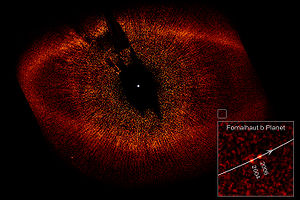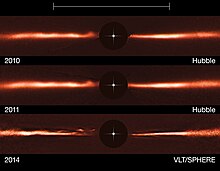
The nebular hypothesis is the most widely accepted model in the field of cosmogony to explain the formation and evolution of the Solar System. It suggests the Solar System is formed from gas and dust orbiting the Sun which clumped up together to form the planets. The theory was developed by Immanuel Kant and published in his Universal Natural History and Theory of the Heavens (1755) and then modified in 1796 by Pierre Laplace. Originally applied to the Solar System, the process of planetary system formation is now thought to be at work throughout the universe. The widely accepted modern variant of the nebular theory is the solar nebular disk model (SNDM) or solar nebular model. It offered explanations for a variety of properties of the Solar System, including the nearly circular and coplanar orbits of the planets, and their motion in the same direction as the Sun's rotation. Some elements of the original nebular theory are echoed in modern theories of planetary formation, but most elements have been superseded.

A protoplanetary disk is a rotating circumstellar disc of dense gas and dust surrounding a young newly formed star, a T Tauri star, or Herbig Ae/Be star. The protoplanetary disk may also be considered an accretion disk for the star itself, because gases or other material may be falling from the inner edge of the disk onto the surface of the star. This process should not be confused with the accretion process thought to build up the planets themselves. Externally illuminated photo-evaporating protoplanetary disks are called proplyds.

A planetary system is a set of gravitationally bound non-stellar objects in or out of orbit around a star or star system. Generally speaking, systems with one or more planets constitute a planetary system, although such systems may also consist of bodies such as dwarf planets, asteroids, natural satellites, meteoroids, comets, planetesimals and circumstellar disks. The Sun together with the planetary system revolving around it, including Earth, forms the Solar System. The term exoplanetary system is sometimes used in reference to other planetary systems.
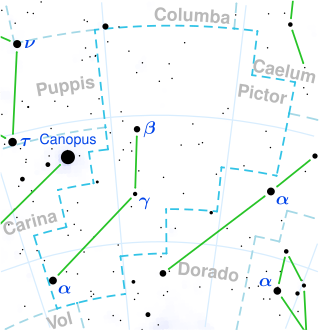
Beta Pictoris is the second brightest star in the constellation Pictor. It is located 63.4 light-years (19.4 pc) from the Solar System, and is 1.75 times as massive and 8.7 times as luminous as the Sun. The Beta Pictoris system is very young, only 20 to 26 million years old, although it is already in the main sequence stage of its evolution. Beta Pictoris is the title member of the Beta Pictoris moving group, an association of young stars which share the same motion through space and have the same age.
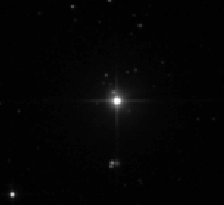
AU Microscopii is a young red dwarf star located 31.7 light-years away – about 8 times as far as the closest star after the Sun. The apparent visual magnitude of AU Microscopii is 8.73, which is too dim to be seen with the naked eye. It was given this designation because it is in the southern constellation Microscopium and is a variable star. Like β Pictoris, AU Microscopii has a circumstellar disk of dust known as a debris disk and at least two exoplanets, with the presence of an additional two planets being likely.
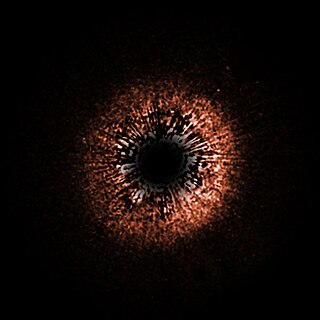
HD 107146 is a star in the constellation Coma Berenices that is located about 90 light-years (28 pc) from Earth. The apparent magnitude of 7.028 makes this star too faint to be seen with the unaided eye.
HD 150706 is a star with an orbiting exoplanet in the northern constellation of Ursa Minor. It is located 92 light years away from the Sun, based on parallax measurements. At that distance, it is not visible to the unaided eye. However, with an apparent visual magnitude of 7.02, it is an easy target for binoculars. It is located only about 10° from the northern celestial pole so it is always visible in the northern hemisphere except for near the equator. Likewise, it is never visible in most of the southern hemisphere. The star is drifting closer to the Sun with a radial velocity of −17.2 km/s.
HD 210277 is a single star in the equatorial constellation of Aquarius. It has an apparent visual magnitude of 6.54, which makes it a challenge to view with the naked eye, but it is easily visible in binoculars. The star is located at a distance of 69.6 light years from the Sun based on parallax, but is drifting closer with a radial velocity of −20.9 km/s.
HD 69830 is a yellow dwarf star located 41.0 light-years away in the constellation of Puppis. In 2005, the Spitzer Space Telescope discovered a narrow ring of warm debris orbiting the star. The debris ring contains substantially more dust than the Solar System's asteroid belt. In 2006, three extrasolar planets with minimum masses comparable to Neptune were confirmed in orbit around the star, located interior to the debris ring.
Eta Telescopii is a white-hued star in the southern constellation of Telescopium. This is an A-type main sequence star with an apparent visual magnitude of +5.03. It is approximately 158 light years from Earth and is a member of the Beta Pictoris Moving Group of stars that share a common motion through space. It is moving through the Galaxy at a speed of 23.7 km/s relative to the Sun.

Any planet is an extremely faint light source compared to its parent star. For example, a star like the Sun is about a billion times as bright as the reflected light from any of the planets orbiting it. In addition to the intrinsic difficulty of detecting such a faint light source, the light from the parent star causes a glare that washes it out. For those reasons, very few of the exoplanets reported as of April 2014 have been observed directly, with even fewer being resolved from their host star.

Eta Corvi is an F-type main-sequence star, the sixth-brightest star in the constellation of Corvus. Two debris disks have been detected orbiting this star, one at ~150 AU, and a warmer one within a few astronomical units (AU).
HD 210277 b is an extrasolar planet orbiting the star HD 210277. It was discovered in September 1998 by the California and Carnegie Planet Search team using the highly successful radial velocity method. The planet is at least 24% more massive than Jupiter. The mean distance of the planet from the star is slightly more than Earth's distance from the Sun. However, the orbit is very eccentric, so at periastron this distance is almost halved, and at apastron it is as distant as Mars is from the Sun.

Fomalhaut b, formally named Dagon, is a directly imaged extrasolar object and former candidate planet observed near the A-type main-sequence star Fomalhaut, approximately 25 light-years away in the constellation of Piscis Austrinus. The object's discovery was initially announced in 2008 and confirmed in 2012 via images taken with the Advanced Camera for Surveys (ACS) on the Hubble Space Telescope. Under the working hypothesis that the object was a planet, it was reported in January 2013 that it had a highly elliptical orbit with a period of 1,700 Earth years. The planetary hypothesis has since fallen out of favor; more recently gathered data suggests a dust or debris cloud is far more likely, and more recent analysis placed the object on an escape trajectory.

HD 172555 is a white-hot Type A7V star located relatively close by, 95 light years from Earth in the direction of the constellation Pavo. Spectrographic evidence indicates a relatively recent collision between two planet-sized bodies that destroyed the smaller of the two, which had been at least the size of the Moon, and severely damaged the larger one, which was at least the size of Mercury. Evidence of the collision was detected by NASA's Spitzer Space Telescope.
51 Ophiuchi is a single star located approximately 410 light years away from the Sun in the equatorial constellation of Ophiuchus, northwest of the center of the Milky Way. It is visible to the naked eye as a faint, blue-white point of light with an apparent visual magnitude of 4.81. The star is moving closer to the Earth with a heliocentric radial velocity of –12 km/s.

Paul Kalas is a Greek American astronomer known for his discoveries of debris disks around stars. Kalas led a team of scientists to obtain the first visible-light images of an extrasolar planet with orbital motion around the star Fomalhaut, at a distance of 25 light years from Earth. The planet is referred to as Fomalhaut b.
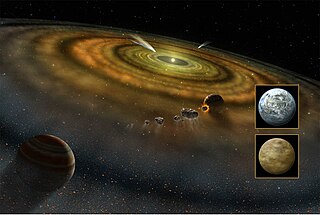
An exocomet, or extrasolar comet, is a comet outside the Solar System, which includes rogue comets and comets that orbit stars other than the Sun. The first exocomets were detected in 1987 around Beta Pictoris, a very young A-type main-sequence star. There are now a total of 27 stars around which exocomets have been observed or suspected.
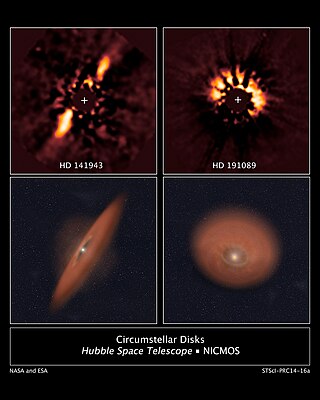
A circumstellar disc is a torus, pancake or ring-shaped accretion disk of matter composed of gas, dust, planetesimals, asteroids, or collision fragments in orbit around a star. Around the youngest stars, they are the reservoirs of material out of which planets may form. Around mature stars, they indicate that planetesimal formation has taken place, and around white dwarfs, they indicate that planetary material survived the whole of stellar evolution. Such a disc can manifest itself in various ways.
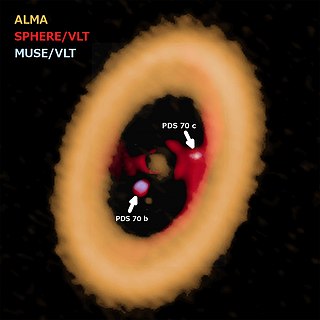
A circumplanetary disk is a torus, pancake or ring-shaped accumulation of matter composed of gas, dust, planetesimals, asteroids or collision fragments in orbit around a planet. Around the planets, they are the reservoirs of material out of which moons may form. Such a disk can manifest itself in various ways.
